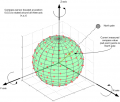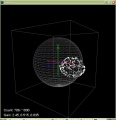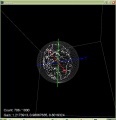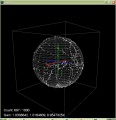IMU: Unterschied zwischen den Versionen
(→Calibration abstract) |
(→Calibration abstract) |
||
| Zeile 48: | Zeile 48: | ||
==Calibration abstract== | ==Calibration abstract== | ||
This one-time calibration ensures that: | This one-time calibration ensures that: | ||
| − | + | *All 3 axes measurements of the acceleration sensor are weighted equally. This calibration can be performed even outside of the robot. | |
| − | + | *Cable, metal, etc. which is located in the robot near the IMU module has no effect on the compass data. | |
Why is it needed? | Why is it needed? | ||
| Zeile 61: | Zeile 61: | ||
There are two types of disturbances of the magnetic field which change / move the values: | There are two types of disturbances of the magnetic field which change / move the values: | ||
| − | Hard ircon (e.g. magnets): the sphere moves | + | *Hard ircon (e.g. magnets): the sphere moves |
| − | Soft ircon (e.g. metal): the sphere deforms (becomes an Ellipsoid) | + | *Soft ircon (e.g. metal): the sphere deforms (becomes an Ellipsoid) |
Example measurements | Example measurements | ||
Version vom 12. September 2014, 11:45 Uhr
Inhaltsverzeichnis
Abstract
An IMU (Intertial Measurement Unit) is key component of an intertial navigation system. We use it to:
- detect if the robot is in tilt orientation
- keep the robot on track for the 'lane-by-lane' mowing pattern
Acceleration sensor
An acceleration sensor measures earth gravity force (m*s^2) in all 3 robot axes (x/y/z) allowing you to calculate the orientation towards earth center of the robot (Roll, Pitch). However, it cannot detect movement around Yaw - this requires a gyro.
Gyro
A gyro measure rotation speed (degree/second) in all 3 robot axes (Rol, Pitch, Yaw). This allows us to correct the robot if it is driving 'off-course' due to wet conditions or slope.
Compass
If a robot drives on a wet lawn, you'll notice quickly that it will not drive straight forward, but instead tends to drive into the direction of the slope. A compass can solve this problem and the robot will drive again straight forward.
However, a compass has a problem: if tilting the robot, the compass measurements (x,y,z) relate to the tilted robot. So, you need to correct them using knowing the tilt angles. This requires the use of the accerlation sensor (x,y).
Sensor fusion
To eliminate the issues of all sensor, they are merged to compute the course (degree) and pitch/roll angles.
We use a complementary filter to fusion all sensor values.
IMU module GY-80
- Acceleration sensor: ADXL345B
- Compass sensor: HMC5883L
- Gyro: L3G4200D
- Pressure sensor: BMP085 (not used here)
Assembly
This photo shows how the IMU module is placed in driving position (the black arrow shows the driving position). The shown tube was a prototype. Actually, you can now place the IMU module directly in the robot.
Calibration abstract
This one-time calibration ensures that:
- All 3 axes measurements of the acceleration sensor are weighted equally. This calibration can be performed even outside of the robot.
- Cable, metal, etc. which is located in the robot near the IMU module has no effect on the compass data.
Why is it needed? A measured value (x, y, z) of a 3D compass points (as seen by his origin 0,0,0) always in one direction: to the north pole. If you rotate the 3D compass around all of its axes, all measured values lie on a sphere:
If you add a magnetic material (e.g. metal) near the compass, the measured values from the origin (0,0,0) of the sensor suddenly point in one direction only - Why? There are two types of disturbances of the magnetic field which change / move the values:
- Hard ircon (e.g. magnets): the sphere moves
- Soft ircon (e.g. metal): the sphere deforms (becomes an Ellipsoid)
Example measurements
Calibration (v0.9.3)
Acceleration sensor
This one-time calibration ensures that all 3 axes measurements are weighted equally. This calibration can be performed even outside of the robot.
1. Connect the Arduino Nano to your PC. On the PC, open the serial console (19200) in the Arduino environment. After the automatic gyro calibration menu appears (this can be shown at any time by pressing the "m" + ENTER keys).
2. Start the calibration by pressing "1" + ENTER keys.
2.1. After calibration, each of the 6 sides of the module has to look up-side and down-side (rotated 180 °). The module has 6 sides, so it must be rotated 6 times, so that each side once is on the table (you can hold the module with your hand without moving it). Press ENTER after each calibration step. The aim of the calibration to determine the acceleration due to gravity (more precisely, the minimum / maximum value) for each axis . The module must not be artificially accelerated. The order of the sides does not matter.
Finally, the calibration values for acceleration sensor are printed out on serial console.
Compass sensor
First ensure that the IMU module is mounted on the final position and that entire robotic electronic equipment and metal objects are 30cm or more away from it (ie the sensor is not distracted by metallic objects in its environment).
1. Download ArduMag calibration app for Android. 2. If not done yet, pair your Android device with the Bluetooth module: On the Android device main screen, choose symbol "Settings" (via Android menu). Now choose "Wirless and Networks->Bluetooth Settings" and "Find device". Finally, choose "pair with this device" and enter your pin (very often "1234"). The Bluetooth module should now appear as "paired". 3. In the ArduMag app, press the Android menu key and then "Bluetooth" to connect with your Bluetooth module (and your robot). The robot should confirm the connection with a beep. The number of measurements should increase.
Turn around the robot slowly for all axes and all 6 sides for at least 360 degrees:
The order of the axis of rotation and the direction does not matter. For example, rotate each side 180 degree clockwise and then again 180 degree counterclockwise (result is a 360 degree rotation). The measurements may not fit a sphere. Examples:
Finally, press 'Calibrate' to finish the calibration. The robot will confirm the calibration with two beeps. The measurements should fit a sphere now. Examples:
Calibration (SVN version)
Acceleration sensor
Jede der 6 Seiten des Moduls einmal exakt hochkant hinstellen, nicht bewegen und den Punkt zur Kalibrierung der nächsten Seite auswählen:
- In der seriellen Konsole "IMU acc calibration next side" oder
- In der pfodApp "Settings->IMU->acc calibration next side"
Während der Messung einer Seite das Modul nicht bewegen! Die Messung wird begleitet von einem kurzen Ton.
Diesen Schritt für alle 6 Seiten wiederholen. Wenn alle 6 Seiten kalibriert wurden, ertönt ein kurze Melodie.
Compass sensor
Modul außer Reichweite von magnetischen oder eisenhaltigen Quellen bringen! Kompaß-Kalibrierung starten:
- In der seriellen Konsole "IMU com calibration start/stop" oder
- In der pfodApp "Settings->IMU->com calibration start/stop"
Jede der 6 Seiten des Moduls einmal Richtung Norden halten und das Modul solange kippen bis sich das Minimum und Maximum der Achsen nicht mehr ändert (kein Ton mehr ausgegeben wird):
Calibration test
Zum Testen der Kalibrierung Modul (Bauteilseite nach oben) mit einer Seite gegen eine Tischkante halten und nicht bewegen. Den Yaw-Wert notieren (Beispiel: -95,45). Dann das Modul um 180 Grad drehen und wieder gegen die Tischkante halten. Jetzt sollte der Yaw-Wert um 180 Grad entfernt liegen (Beispiel: -95,45 + 180 = 84,55). Diesen Test mit den beiden anderen Seiten des Moduls ebenfalls durchführen.
... Modul mit einer Seite gegen Tischkante gehalten ...
calls=30 yaw=-95.56 pitch=0.02 roll=2.52 com=-95.91 com180=84.09 gyroZ=0.00 calls=30 yaw=-95.48 pitch=-0.11 roll=2.33 com=-95.81 com180=84.19 gyroZ=-0.01 calls=30 yaw=-95.42 pitch=0.03 roll=2.42 com=-95.65 com180=84.35 gyroZ=-0.00 calls=30 yaw=-95.45 pitch=-0.21 roll=2.38 com=-95.35 com180=84.65 gyroZ=-0.00
... Modul mit derselben Seite um 180 Grad gedreht gegen Tischkante gehalten...
calls=30 yaw=85.06 pitch=-2.50 roll=0.04 com=84.91 com180=-95.09 gyroZ=-0.03 calls=30 yaw=84.90 pitch=-2.59 roll=0.05 com=84.63 com180=-95.37 gyroZ=-0.02 calls=30 yaw=85.19 pitch=-2.55 roll=0.01 com=84.73 com180=-95.27 gyroZ=-0.01 calls=30 yaw=84.98 pitch=-2.73 roll=0.02 com=84.85 com180=-95.15 gyroZ=-0.01
Falls die Abweichung mehr als ein Grad beträgt, Kalibrierung von Beschleunigungssensor und Kompaß erneut durchführen!
Man kann sich die Ergebnisse des IMU-Moduls (Yaw, Pitch, Roll) auch mit der pfodApp plotten lassen:

















